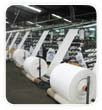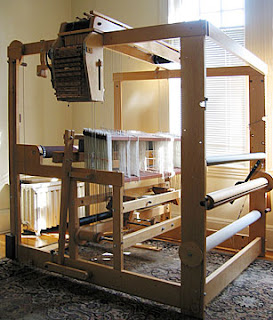Loom | How Many Motions A Loom Can Have?
What Is Loom:
Loom is the machine which produces the woven fabric by interlacing of two sets of yarn.
Loom’s Motion:
Primary Motion:
1. Shedding
2. Picking.
3. Beating
Secondary Motion:
- Take Up Motion.
a) 5 Wheel take up motion.
b) 6Wheel take up motion.
c) 7 Wheel take up motion.
- Let-off Motion:
a) Positive Let-off motion
b) Negative Motion.
Tertiary Motion:
- Warp Stop Motion.
- Weft stop motion.
- Warp Protector motion
- Feeler Motion.
- Brake Motion
- Weft Mixing Motion.
Shed Weaving in Loom | Tappet, Dobby, Jacquard Shedding
Definition of Weaving Shedding:
It is the process by which the warp threads are divided into two layer parts, are above the other, for the passage of the shuttle with a pick of weft. Shed weaving is done due to passing the weft yarn over the warp yarn on the slay race of a weaving loom.Classification of Shedding:
Shedding are basically classified as follows:1. Tappet Shedding. –
a) Positive shedding,
b) Negative Shedding.
2. Dobby Shedding.-
a) Positive dobby shedding,
b) Negative dobby shedding.
3. Jacquard Shedding. –
a) Single lift single cylinder jacquard
b) Single lift double cylinder.
c) Double lift single cylinder.
d) Double lift double cylinder.
Shed of Weaving Loom
Definition of Weaving Loom Shed:
The warp threads are divided into two layers or parts one above the other, for the passage of the shuttle with a pick of weft. The space or gap between the two layers of the warp threads is called shed. A shed is produced by means of healds or harnesses.Types of Shed:
Shed is classified according to the position of the ends:1. Closed Shed
2. Bottom Shed.
1. Closed Shed is classified on two parts. A) Bottom Closed Shed, B) Centre Closed Shed.
2. Open Shed are classified on two parts. A) Semi-open Shed, b) Open Shed.
Bottom Closed Shed:
This kind of shed is produced by giving motion only to threads that are to form the upper line. Under this condition the warp is level on the bottom line. Hence in order to form a top shed, it is necessary to move some threads through a space equal to twice the depth of a shed, once up and once down, before a fresh selection is made. A shade of this kind is known as a stationary bottom with a rising and falling top.Centre Closed Loom Shed:
Centre closed shed is produced by imparting an upward movement to those threads which are to form the top line and a downward movement to the threads which are to form the bottom line, then after inserting a pick, both the lines meet at the centre.Loom Drives | Hand loom & Power Loom Driver’s features.
The Loom Drives are describes below with it’s type and convenience: -
Weaving Loom Drives are of two types:-
1. Hand drive used in hand loom.2. Power drive used in power loom.
The power drive of Loom is given by-
a) Water Wheel.b) Steam Engine.
c) Common Motor like 1. Single Large Motor. 2. Grouped Motor.
d) Individual Motor.
Advantages of Grouped Motor in loom:
1. Economical with respect to fixed charges and maintenance.2. Initial cost is low.
Disadvantages of Grouped Motor in loom:
1. Shafts, belts, pulleys etc absorb greater power and efficiency is considerably low.2. In case of motor failure, all the looms of that motors are workless.
3. Fluff accumulates and occasionally falls on loom warp and cloth causing damage to cloth.
4. Gives greater power cost for driving causes of power losses.
5. Lay out is difficult.
Individual Motor:
In modern system, each loom has its own electric motor and starter. The motor may drive the loom through a belt or gear.Advantages of Individual motor in Loom:
1. There is considerable economy of power as power losses are small.
2. In case of motor failure, only a particular loom remains idle and this does not affect the working of other machines.
3. Lay out of loom is very easy.
4. It gives a clear view of the shed and the working hazard being reduced.
5. No chance of any accident, cleanliness and lightning s are also improved because elimination of overhead shaft and long belts.
Disadvantages of Individual motor in Loom:
1. High initial cost.2. High maintenance cost.
3. There is always a risk of hazards.
Loom | Loom Motion
What Is Loom:
Loom is the machine which produces the woven fabric by interlacing of two sets of yarn.Loom’s Motion:
Primary Motion:1. Shedding
2. Picking.
3. Beating
Secondary Motion:
1. Take Up Motion.
a) 5 Wheel take up motion.
b) 6Wheel take up motion.
c) 7 Wheel take up motion.
2. Let-off Motion:
a) Positive Let-off motion
b) Negative Motion.
Tertiary Motion:
1. Warp Stop Motion.
2. Weft stop motion.
3. Warp Protector motion
4. Feeler Motion.
5. Brake Motion
6. Weft Mixing Motion.
Chronological Development of Loom
The today’s modern loom has not yet come automatically. After passing a long period modern loom has been invented. Now I will show you the successive steps of getting the ultra modern loom.
Ø Up right Vertical Frame
Ø Shed Stick Weaving
Ø Primitive Loom-
1. Pit Loom,
2. Through Shuttle Loom.
Ø Fly Shuttle Loom-This was invented by the Jhon K Burrey
Ø Semi Automatic Loom.
- Chittarangon Loom
- Hattersely Loom.
Ø Ordinary Power Loom
Ø Automatic Power Loom- it was invented in 1890 to 1899 Christ.
Ø Shuttle-less or Modern Loom.
Shuttle less or Modern Loom was invented in 1960.
Weaving | Parts of Weaving Loom | Pick Spacing of Warp Yarn
What Is Weaving:
Weaving is the process of producing a fabric by the interlacement two sets of yarns.Parts of Weaving Loom:
1. Weaver’s Beam/ Warp Beam. 2. Back Rest.
2. Back Rest.3. Lease Rod.
4. Drop Wire.
5. Heald Wire.
6. Heald Shaft.
7. Heald Eye.
8. Top roller with large dia.
9. Top roller with small dia.
10. Sley Sword.
11. Race Board.
12. Reed.
13. Shuttle.
14. Fell of the cloth.
15. Front Rest.
16. Take up Roller.
17. Pressure Roller.
18. Cloth Roller.
19. Rocking Rail.
20. Treadle Lever.
21. Bottom Shaft.
22. Shedding Tappet.
23. Fulcrum.
24. Treadle Bowl.
Pick Spacing in Weaving:
Pick spacing is the distance between two picks or distance between stitch of warp. If P.P.I is 50 then pick spacing will be 1/50″ .Step By Step How The Loom Has Been So Much Modern?
Now, the Mechanical Engineers along with Textile Engineers are gathered together to invent more efficient looms to increase the productivity of the fabrics.
Day by day the machines of textile industry getting modern and more faster. Now I will show you the successive steps of getting the ultra modern loom.
>Up right Vertical Frame
> Shed Stick Weaving
> Primitive Loom-
1. Pit Loom,
2. Through Shuttle Loom.
>Fly Shuttle Loom-This was invented by the Jhon K Burrey
> Semi Automatic Loom.
1. Chittarangon Loom
2. Hattersely Loom.
>Ordinary Power Loom
> Automatic Power Loom- it was invented in 1890 to 1899 Christ.
> Shuttle-less or Modern Loom.
Shuttle less or Modern Loom was invented in 1960.
I will tell you later about some ultra modern looms. Just keep visiting textileclass.com to keep you updated.
Weaving Loom’s Shedding | Picking | Beating | Let & Take Up Motion
Weaving Shedding:
It is the process of separating the warp threads into two layers to form a tunnel, called shed through which shuttle carrying weft passes is known as shedding. Some warp threads are raised up and some are depressed down to create the tunnel in the loom.Loom’s Picking:
The method of passing the weft threads which traverses across the fabric through shed is called picking. The insert4ed weft is known as pick.Beating:
It is the process of pushing the pick into the ready woven fabric at a point known as fell of the cloth.Let- off Motion: The motion which delivers warp in the weaving area at the requi4rd rate and at a suitable constant tension by unwinding it from a flanged beam called let-off motion.
Take-up Motion:The motion which withdrawals fabric from the weaving area; at the constant rate that will give the required spacing and winds the fabric onto a roller is called take up motion.










Post a Comment